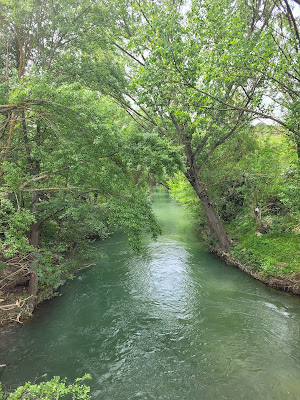Today's prompt:
The "puente" at Puente la Reina, built in the 11th century, is one of the most emblematic bridges of the Camino Francés. It is practical, but it is also symbolic. Study the bridge closely. Look at its shapes and structure. Think of the people, the common laborers who builit it, cut the stone, performed the excavations, provided food; imagine the engineering expertise required to design and assemble it. How llong might it have taken to construct? Now think about symbolic bridges, the events and people that make others kinds of "crossings" possible. What is required to build these bridges? How might you build bridges on your Camino?
We have seen A LOT of bridges along the way. They have been strategically placed to make movement along the path easier. These bridges are helpful and provide tremendous support to the pilgrims. We can be like those bridges in the lives of others. We can help them span the adversities that they face by teaching them how to build firm foundations on which to construct their own bridges. We can also bridge generations through good works, inspiring stories, faithful service, and love of God and the gospel.
Here are pictures from the day, leaving Puente la Reina to Estella:
Exiting the city of Puente la Reina heading for the bridge...
This magnificent Romanesque bridge was built in the 11th Century and spans the Arga River. It is said that when you reach the high point of the inverted V-shaped bridge you symbolically go from one way of living to another that is presumably better.
All along the trail you find vast fields of wheat and barley.
It is poppy season in Spain. You will find poppies growing interspersed in fields along the way.
Today we walked through three hilltop towns. This is Cirauqui.
Clearly we are beginning to enter wine country with acres upon acres of vineyards.
Just before you begin the descent from the hill you catch this view of the valley below. Absolutely stunning!
You leave Cirauqui trudging downhill along an original Roman road. This road leads to a beautiful bridge (see following two pictures)
The road leads to the bridge below.
And we continue on... through fields of barley, olive trees, and vineyards.
And guess what? We come upon yet another medieval bridge!
Walking along the Roman road we came to a place called "Gardzen." The keepers of the space are neo-hippy types who are trying to preserve the road and create a peaceful space for the pilgrims with flowers, chairs, benches and shady spots where they can sit and meditate.
And another bridge, this one not far from the Canal de Alloz
So that pilgrims don't get lost there are these pilasters with the symbol of the trail. Here someone decided to offer a little comic relief and created a stone cairn with a froggy face!
Oh, another bridge. This one over the Río Iranzu (Villatuerta). I think that it is important to know that many of these bridges date from 13th century and facilitated commerce in the region.
Just as we were leaving Villatuerta we came upon the Ermita de San Miguel Arcángel. Originally built as a church at the end of the 10th century under the rule of Sancho II. In the 17the century it became a hermitage.
Inside was a simple altar with letters requesting blessings.
We continue to cross rivers...
and are almost to Estella. I just can't help taking pictures of the poppies. Just above this cluster you will see a yellow arrow. That is also one of the other signals that we find along the way.
Entering Estella is this place where pilgrims can fill their water bottles. The inscription reads:
Buen pan
Excelente agua
y vino, carne y
pescado llena de
toda felicidad
[Good bread
Excellent water
and wine, meat and
fish filled
with all happiness]
Below is the Río Ega that flows through Estella. We are on our way to see the Iglesia de San Pedro de la Rua.
San Pedro de la Rua with its massive staircase and beautiful cloister (below). Construction began in the 13 century and continued in phases. The staircase was built in 1966 to give better access to the church.
The cloister is from the 12 century.
An interesting note: the neighborhood just below this church is part of the old medieval Jewish quarter of Estella. Going out to have Kebabs for dinner we discovered that there is still a very distinct Muslim influence and neighborhood.
That is all for today. Tomorrow will bring more adventures.

































Love this post--beautiful images!
ReplyDelete